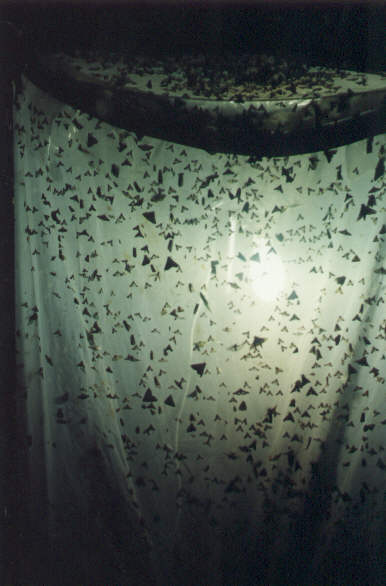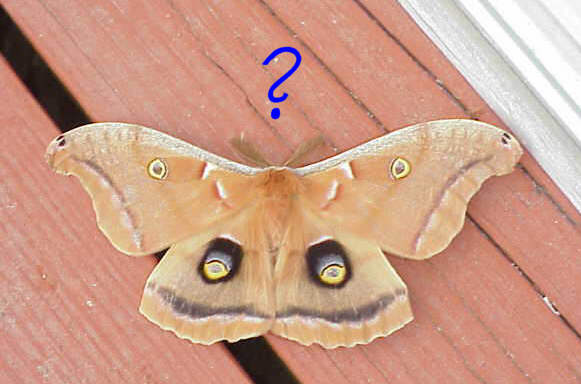|
|
|
Why are moths attracted to lights...
by Dr. James K. Adams, Dalton State College
![]()
In studies done on the sensitivity of moth optical neurons to light, they have an extremely low threshold, meaning that even very low levels of light will allow the moths to "see". Not see necessarily sharply, but undoubtedly enough to avoid large (dark) objects.
| Why would moths need to
navigate or to orient using light ? All organisms need to
be able to orient themselves in their environment in
relation to other objects (foodplants, mates, finding
shelter, etc.). I grant you that finding foodplants and
mates for moths flying at night is almost exclusively
done using chemical cues. However, when just
"cruising" moths need cues that will allow them
to maintain appropriate orientation to surrounding
objects, the ground, etc., and one of the cues that is
consistent for moths is that light sources (back before
the advent of human-made light sources) were predictably
"UP" (in the sky). I grant you that the moon is
not always at a consistent angle upward in the sky, but
it *is* always up, as are the stars. Do moths migrate ? The answer is "yes". Not necessarily in masses like the Monarch Butterfly, and not necessarily in a particular direction at a particular time of the year, but moths do fly long distances and likely use the sky light cues in the sky *directionally* as well (though little research has been done on this). |
 |
For instance, there is some documentation for the movement of moths out of the west coast lowlands of Costa Rica during the dry season up into the moister mountainous areas to the east, and back down into the coastal dry forest during the rainy season.
The observation that moths fly more strongly on humid, cloudy nights is also well documented, but to say that it doesn't make much sense therefore that they would use lights as a navigational cue doesn't necessarily follow. Most animals have *more than one* way to navigate through their environment, and just because they don't necessarily use one all the time doesn't mean they *can't*. (Moths *do* have functional eyes, after all!!).
Just as an off the wall example, homing pigeons can use sun compass and magnetic cues to migrate -- a pigeon released on a sunny day with a small magnet attached to its head (which screws up their magnetic sense) can still navigate just fine. Unencumbered pigeons do just fine on a cloudy day as well. However, release a pigeon with a magnet on its head on a cloudy day and they fly around aimlessly.
Moths undoubtedly can use lights as a navigational cue, and along with gravitational cues, use the light sources from above to maintain appropriate "up-down" orientation in their environment. Noctuid moths migrate using the moon as a primary reference point. To calibrate the location in the sky with actual geographical direction, they periodically use an internal geomagnetic compass. In fact, every hour, they alter their flight path by 16 degrees to correct for travel of the moon across the sky (for purists, rotation of the earth). On moonless nights they navigate solely with the geomagnetic compass. I guess using the moon is 'easier', and therefore they 'prefer' that when it is visible, hence the screwup when bright lights are visible."
Just as an aside, fish are used to coming to the surface of the ocean during a full moon -- this is well documented for many fresh water fish as well. Perhaps one of the reasons is that insects flying through their environment on a well moonlit night will be confused by *reflected* moonlight from below and go cascading down into the water (more food for the fish). I know this has come up in discussions with other entomologists before, but I am unaware if this is actually scientifically documented.
Are moths able to hear the light and come to the light based on certain sound frequencies being produced by the lights ?

I agree that this may be a possibility, but there are three things which suggest that this is certainly not the only, or even an important, mechanism. I doubt very seriously that white light bulbs and white light bulbs painted yellow emit significantly different sound impulses, and so this would not explain why moths come in to different colored lights in significantly different numbers. Secondly, there are some families of moths which, in essence, have *no* hearing capabilities whatsoever (for instance, the Saturniidae [egs., Polyphemus, Cecropia, Io, Imperial, etc.]), so without the ability to hear sound frequencies, saturniids and some other moths would never end up at lights, and this is certainly not the case. Lastly, and perhaps most importantly, there would have to be some reason why the sound is *meaningful* to the moths, and I doubt that this would be likely for most moth species. Only a few moths actually use any kind of acoustic communication, so for the majority of moths, sounds at night are likely to indicate danger (flee!) as opposed to some sort of attraction.
The use of moon and stars as navigational cues can at least partly explain why moths end up at lights. Moths maintain a certain angle between themselves and light sources, which explains the "spiralling in" that is easily observable in many species as they come to lights. Interestingly, some of the species that do this most strikingly, such as the saturniids, are also some of the species that do not have hearing apparati. The reason why they stay at the lights (after "hitting" the moon, an accomplishment they never evolved a decent response to ) is because it is now bright.
 |
Now close to a bright light source, the artificial "moon" has become the "sun", and the moths settle down . . . for their daytime "sleep". However, I do doubt that these moths are then as result (at least not the first time they come into the lights) half-starved. The reason why some moths simply fall from the wall when tapped has to do with thermoregulation. Cooled moths (in many cases) require a certain warm up period before flight (accomplished by "shivering" [muscular thermogenesis]). Being half starved is irrelevant for some species which do not feed as adults, such as the saturniids mentioned above. Using nighttime celestial lights sources as navigational cues would also be a convenient explanation as to why it appears that fewer moths come to lights on well moonlit nights. Full moonlight is harder to compete with using the superstimulating electric light sources, as well as why it therefore may appear that there is *more activity* at artificial light sources on cloudy nights, though cloudy nights also tend to be warmer and more humid, which may have more of an effect. However, this is certainly not the entire story. Many, many moths, if you watch them come to lights, fly *directly* at the light source as they come in, with little indication of any spiral. Many moths can hear, and it is these moths which appear to come more directly at the light. It is possible, and I stress simply *possible* that these moths are perhaps using *both* a light and sonic cue to get to the light. This does *not*, however, explain why the moths "like" either the light or the sound. |
As to the decline of species because of artificial lighting, the main reason for this (assuming it does happen) is the predation that occurs on the placid moths sitting on walls, etc. in the morning (not against some background that they might be camouflaged on). I have seen numerous birds "cleaning up" in the early morning, as well as Bald-Face Hornets and wasps of the genus Tripoxylon. There may indeed be some selection going on for individual moths that do *not* respond strongly to light cues (but, of course, if the navigational argument is sound, it would be impossible to select this out of a moth species!!).